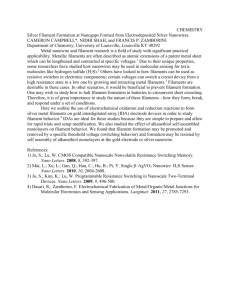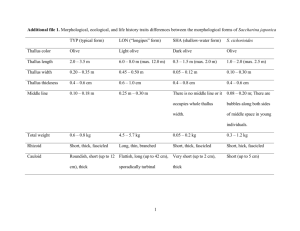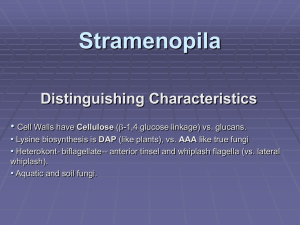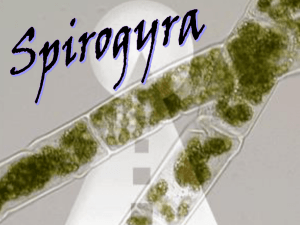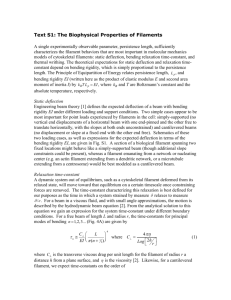chapter - New Age International
advertisement
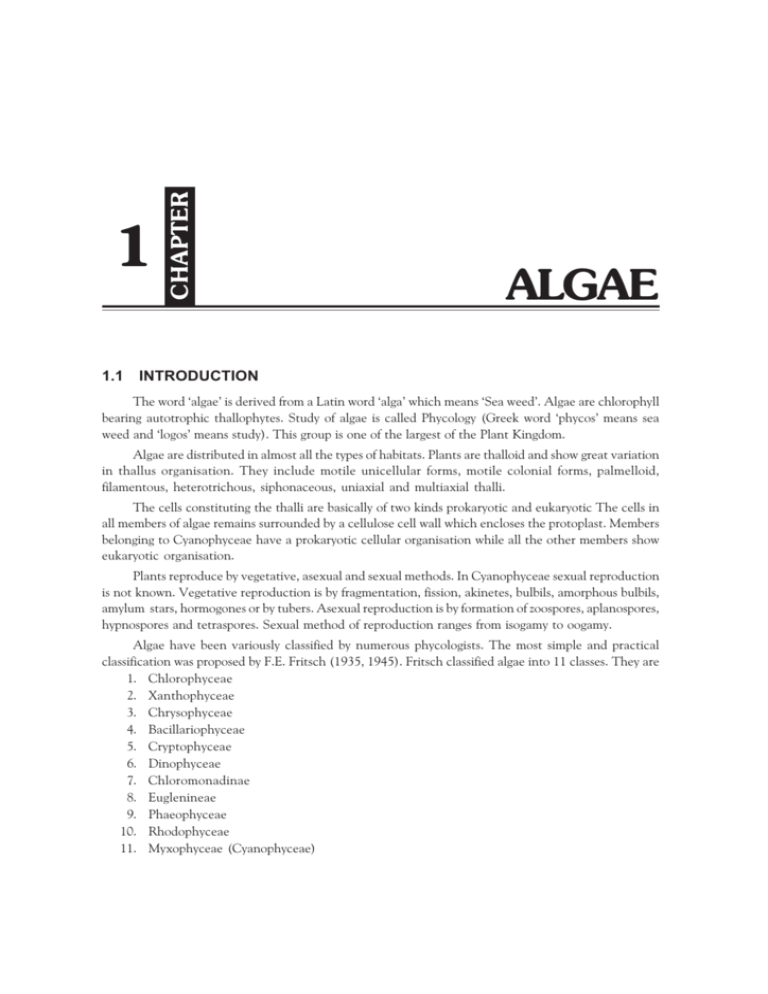
1.1 CHAPTER 1 ALGAE INTRODUCTION The word algae is derived from a Latin word alga which means Sea weed. Algae are chlorophyll bearing autotrophic thallophytes. Study of algae is called Phycology (Greek word phycos means sea weed and logos means study). This group is one of the largest of the Plant Kingdom. Algae are distributed in almost all the types of habitats. Plants are thalloid and show great variation in thallus organisation. They include motile unicellular forms, motile colonial forms, palmelloid, filamentous, heterotrichous, siphonaceous, uniaxial and multiaxial thalli. The cells constituting the thalli are basically of two kinds prokaryotic and eukaryotic The cells in all members of algae remains surrounded by a cellulose cell wall which encloses the protoplast. Members belonging to Cyanophyceae have a prokaryotic cellular organisation while all the other members show eukaryotic organisation. Plants reproduce by vegetative, asexual and sexual methods. In Cyanophyceae sexual reproduction is not known. Vegetative reproduction is by fragmentation, fission, akinetes, bulbils, amorphous bulbils, amylum stars, hormogones or by tubers. Asexual reproduction is by formation of zoospores, aplanospores, hypnospores and tetraspores. Sexual method of reproduction ranges from isogamy to oogamy. Algae have been variously classified by numerous phycologists. The most simple and practical classification was proposed by F.E. Fritsch (1935, 1945). Fritsch classified algae into 11 classes. They are 1. Chlorophyceae 2. Xanthophyceae 3. Chrysophyceae 4. Bacillariophyceae 5. Cryptophyceae 6. Dinophyceae 7. Chloromonadinae 8. Euglenineae 9. Phaeophyceae 10. Rhodophyceae 11. Myxophyceae (Cyanophyceae) Practical Manual for Botany, Vol.-I 2 1.2 OSCILLATORIA Division Cyanophyta Class Cyanophyceae Order Nostocales Family Oscillatoriaceae Genus Oscillatoria Identifying Characters 1. Trichomes are without heterocysts and without branching (A single row of cells in a filamentous colony is known as trichome). The trichome along with sheath is called filament. 2. Biconcave separating discs are present. 3. Free surface of the terminal cell is thickened to form calyptra. Apical cell Separation disc Hormogonium Fig. 1.1 Oscillatoria : Thallus structure Distinguishing Characters 1. Majority of the species inhabit fresh water while others are marine. They are commonly found as floating masses in rainwater, pools, puddles and also found on moist soils. 2. They may occur singly or interwoven with each other forming extensive masses on terrestrial substrate. 3. It is an unbranched filamentous alga. 4. Each trichome is comprised of numerous cells, which are broader than long and are placed end to end in a row. They are unbranched, cylindrical, lacks a sheath or possess delicate inconspicuous sheath. 5. All cells resemble each other except the terminal cell, which is colourless and variously shaped. This cell has thick outer covering called calyptra. Algae 3 6. Cells are prokaryotic. Each cell has peripheral coloured chromoplasm and central colourless centroplasm. Pigments and reserve food materials are found in chromoplasm. In centroplasm nuclear material is seen. 7. In floating species pseudovacuoles (gas vacuole) are present in the chromoplasm. 8. Trichome exhibit gliding, rotatory, oscillatory movements hence the name Oscillatoria. 9. Reproduction is by fragmentation and hormogone formation. 10. The broken filaments which consist of 23 cells are called hormogones. 11. Hormogones are formed due to death of intercalary cells or by special separating biconcave cells or disc. 1.3 NOSTOC Division Cyanophyta Class Cyanophyceae Order Nostocales Family Nostocaceae Genus Nostoc Identifying Characters 1. Trichomes unbranched, moniliform and contorted. 2. Akinetes and intercalary heterocysts are present. 3. Algae form jelly like balls in which numerous filaments are embedded. 4. Cells are prokaryotic. a Nostoc ball Intercalary heterocyst Akinetes Cyanophycin granule Mucilagenous Sheath Substratum A B Fig. 1.2 Nostoc: A. Gelatinous colony, B. Trichome Practical Manual for Botany, Vol.-I 4 Distinguishing Characters 1. They occur both in aquatic and terrestial habitats. 2. Thallus is filamentous. Filaments do not occur singly but often grow as large colonies of closely packed trichomes, embedded in a firm matrix of gelatinous material. 3. Each trichome is enclosed by its own mucilaginous sheath and is called a filament. 4. Colonies are spherical in shape, solid or hollow. Surface may be smooth or verrucose. 5. Trichomes are unbranched, contorted and moniliform. 6. Cells of the trichome are spherical or oval and joined end to end resembling a string of beads. 7. In between the vegetative cells there are specialized enlarged thick walled empty looking cells called heterocysts. 8. Cells are prokaryotic. They have centrally located centroplasm and peripheral coloured chromoplasm having pigments and reserve food materials. 9. Heterocysts are intercalary or terminal. They are spherical, enlarged, thick walled yellow coloured cells. Each heterocyst has two polar pores plugged by polar nodules, each one adjacent to the neighbouring cell. Terminal heterocysts have a single polar nodule. These help in nitrogen fixation and hormogone formation. 10. Reproduction is by the formation of hormogones and akinetes. Sexual reproduction is absent. 11. Akinetes are thick walled resting resistant spore like vegetative cells. These occur in chains next to heterocyst. 1.4 SCYTONEMA Division Cyanophyta Class Cyanophyceae Order Nostocales Family Scytonemataceae Genus Scytonema False branch Mycilagenous sheath Cells Nodule Heterocyst Fig. 1.3 Scytonema : Thallus structure Algae 5 Identifying Characters 1. Trichomes show false branching. 2. Trichomes have heterocysts. Distinguishing Characters 1. Commonly occurs in sub-aerial habitats. Some are free floating in aquatic habitats. 2. Filaments occur single and trichome remains enveloped in sheath. 3. Filaments show false branching, which is single or geminate (in pairs). 4. False branching occurs due to breakage of trichome within the sheath and one or both the broken ends of trichome protrudes out of the sheath and develop into branches. 5. False branching occurs due to degeneration of one or more intercalary cells by the breakage of trichome near the intercalary heterocyst or by the formation of loops. 6. Trichomes are of same diameter throughout with cylindrical cells. Cells are shorter than broad. 7. Trichome is covered by an individual sheath, which is firm and hyaline or coloured. 8. Heterocysts are intercalary and are of the same size as that of vegetative cells. Branching occurs at the region of hererocyst. 9. Heterocysts are thick walled specialized vegetative cells, help in nitrogen fixation. 10. Cells are prokaryotic with outer coloured chromoplasm and inner colourless centroplasm. 11. Sexual reproduction is absent. 12. Hormogone formation is common mode of multiplication. They are formed at the ends of trichome. 1.5 VOLVOX—COLONY Division Chlorophyta Class Chlorophyceae Order Volvocales Family Volvocaceae Genus Volvox Identifying Characters 1. Thallus is a coenobium. 2. Coenobia are spherical or oval. 3. Chloroplast of individual cell is cup shaped. Distinguishing Characters 1. It occurs as minute green balls of small pinhead size, in temporary and permanent fresh water pools and ponds. Practical Manual for Botany, Vol.-I 6 A Gelatinous sheath Cytoplasmic strands B Fig. 1.4 Volvox sp. (A, vegetative ; B, portion in detail) 2. Thallus is a motile coenobium. 3. Colonies are mostly spherical, round or oval in shape. 4. Colony is a hollow sphere and the motile cells are arranged in a single layer towards the periphery. 5. Layer of cells are surrounded by gelatinous mass forms the outer firm limiting layer. 6. The number of cells in a colony varies from 500 60,000 according to species. Algae 7 7. Each cell in the colony is connected with a few of the neighbouring cells by thin and delicate cytoplasmic strands. 8. Each cell is surrounded by its own gelatinous sheath. 9. All the cells in the colony are Chlamydomonas like. 10. Each cell is biflagellate motile and ovoid. Flagella are whiplash type and anteriorly inserted. Two contractile vacuoles are situated at the base of flagella. Cytoplasm has cup shaped chloroplast with a pyrenoid, an eye spot and a single nucleus. Cytoplasm is rich in volutin granules. 11. It moves through water rotating slowly with one end of the sphere always leading hence rolling alga. 12. Cells in the colony show division of labour only few cells take part in reproduction. 13. Asexual reproduction is by formation of daughter colonies. 14. Sexual reproduction is Oogamous. 15. Colonies may be monoecious or dioecious. 16. Male reproductive organs are antheridia, which develop at the posterior part of the colony. 17. Each antheridium produces 128 or 512 biflagellate sperms, which are liberated as bowl shaped plate or hollow sphere. 18. Female sex organ is oogonium formed at the posterior end. It produces a single egg which is non-motile. 19. Zygote produced as a result of fertilization is thick walled and orange red in colour. The outer layer is often ornamented. VOLVOX—Asexual Reproduction by Daughter Colonies 1. Asexual reproduction in Volvox is by means of daughter colonies. 2. Volvox is a motile colonial coenobium, found in fresh waters. 3. The individual cells are Chlamydomonas like and arranged at the periphery of the coenobium. 4. Asexual reproduction takes place by formation of daughter colonies. 5. About 2 50 cells in the posterior half of the colony enlarge in size and are called gonidial cells, which by repeated longitudinal divisions give rise to daughter colonies. 6. The eight cells are formed by the longitudinal division of the gonidial cells are arranged in a curved plate and is called plakea stage, which by further longitudinal divisions produce several cells arranged in a hollow sphere with a small aperture called phialopore. 7. All the cells are naked and without flagella with anterior end pointed towards the center. 8. Normal orientation is attained by complete inversion of the young coenobium through phialopore. 9. Naked protoplasts secrete cell wall and develop flagella at their anterior ends and develop into daughter colony. 10. The young colonies escape by the disintegration of the parent colony or through a pore at the position of the original gonidium. Practical Manual for Botany, Vol.-I 8 Daughter colonies Fig. 1.5 Volvox sp. parent colony with a number of daughter colonies VOLVOX—Male Colony Showing Antheridia 1. Sexual reproduction in Volvox is oogamous. 2. Antheridia are male reproductive organs. 3. Sex organs may be monoecious or dioecious. 4. Certain cells in the posterior region of the colony enlarge, retract their flagella and form gametangia. 5. The male gametangia are called the antheridia. 6. The protoplast of the antheridium divides longitudinally several times and produces 64 128 cells, which after inversion are grouped as bowl shaped plate. 7. In some species the divisions continue and produce 512 cells arranged in the form of the hollow sphere. Each cell develops into a spermatozoid or sperm. Algae 9 8. Each sperm is biflagellate conical or fusiform structure. 9. The entire mass of biflagellate sperms are liberated as a single unit, which swims freely until it reaches the female colony. B C D E A Fig. 1.6 Volvox colony showing Artheridum A. Antheridium B-C development of sperms D-E antherozoids before and after inversion VOLVOX—Showing Oogonia—Female Colony 1. Oogonia are female reproductive structures. 2. Volvox is a motile coenobial form. It reproduces sexually by oogamous method. 3. Sex organs may be monoecious or dioecious. 4. Few cells at the posterior region enlarge, become rounded or flask shaped, retract their flagella and develop into oogonia. 5. The entire protoplast of the oogonium gets metamorphosed into a single egg or oosphere. 6. The egg has a large central nucleus and a parietal chloroplast having a large central nucleus and numerous pyrenoids and also stored with reserve substances. 7. The oosphere develops a beak like protrusion, which marks the point of entrance of sperm. Sperm Somatic cell Immature egg Oogonium Mature egg Fig. 1.7 Volvox colony showing oogonium and oospore Oospore Practical Manual for Botany, Vol.-I 10 VOLVOX—Zygote 1. In Volvox sexual reproduction is oogamous, and colonies may be monoecious or dioecious. 2. Antheridia and oogonia are developed mostly in the posterior part of the colony. 3. Antheridium produces biflagellate antherozoids and oogonium produces a single egg. 4. Antherozoids fertilize the egg and an oospore or zygote is formed. 5. The zygote is surrounded by a thick wall which is three layered and outer wall layer is smooth or spiny. 6. The thick walled zygote remains in the parent coenobium for some time and develop sufficient haematochrome or red pigment to colour their protoplast orange red. Single cell Parent colony Fagellum Oogonium Fig. 1.8 Volvox. A colony with a zygote 1.6 OEDOGONIUM Vegetative Filament Division Chlorophyta Class Chlorophyceae Order Oedogoniales Family Oedogoniaceae Genus Oedogonium Identifying Characters 1. Thallus multicellular, filamentous and unbranched. 2. Presence of cap cells. Zygote Algae 11 Antheridia Nucleus Vegetative cell Oogonium Egg Suffultor cell Apical caps Apical cap Reticulate chloroplast Cell wall Pyrenoid Pyrenoid Nucleus Cap cell Chloroplast Cell wall Basal holdfast Flattened disc Fig. 1.9 Oedogonium. A monoecious filament Fig. 1.10 Oedogonium cell Practical Manual for Botany, Vol.-I 12 3. Oogonia spherical, larger than the vegetative cell and bears one or more apical rings. 4. Chloroplast is reticulate with pyrenoids at the intersections. OEDOGONIUM–Vegetative Structure 1. It is a common submerged aquatic alga often found attached to a solid object. Mature filaments are free floating. 2. Thallus is filamentous, multi-cellular and unbranched. 3. Filaments are uniseriate. 4. According to position the filaments have three types of cells, (i) Basal (ii) Intercalary (iii) Apical. 5. The basal cell of the filament functions as a hold fast. The lower part of the hold fast is either disc shaped or finger like. Upper part is broad and rounded and lacks pigments. 6. The terminal or apical cell is broadly rounded. 7. The intercalary cells are cylindrical longer than broad and the cell wall is made up of three layers inner cellulose, middle pectin and outer chitin. 8. Internal to cell wall the cells have reticulate chlorplasts with numerous pyrenoids at the inter sections. 9. Cells are uninucleate. Thin delicate cytoplasmic strands suspend nucleus. 10. Some of the cells at their upper end possess small ring like markings called apical rings. These cells are called cap cells. Presence of apical rings indicates that the cells have undergone division. The annular splitting of the lateral cell walls forms apical rings. Number of rings indicates number of times the cell has divided. 11. Asexual reproduction is by means of multiflagellate zoospores, which are produced singly in zoosporangia. 12. Sexual reproduction is oogamous. Female sex organ is oogonium and male sex organs are antheridia. Each antheridium produces two multi-flagellate sperms. On the basis of distribution of antheridia two species of Oedogonium are identified. (1) Macrandrous and (2) Nannandrous. 14. In Macrandrous species, the antheridia are found on the filaments of normal size. 15. In Nannandrous species, antheridia are produced on much reduced male filaments called dwarf males. OEDOGONIUM—Cap Cells 1. Oedogonium is a fresh water alga found in pools, lakes, tanks, etc. 2. The thallus is multicellular, filamentous and unbranched. 3. The basal cells of the filament function as hold fast. 4. The cell at the tip of the filament is the apical cell. Algae 13 5. The intercalary cells are cylindrical with thick walls composed of 3 layers. 6. Certain cells in every filament possess one or more ring like markings known as apical caps at their distal ends and these cells are known as cap cells characteristic feature of the Oedogonium species. 7. The caps are formed as a result of the cell division. The number of caps in a cell indicates the number of times a cell has divided. When a cell divides a thickening is laid down in its upper end in the form of a ring on the inner side of the cell. The latter now stretches to form a new cell. Simultaneously the nucleus of the cell moves upward, divides mitotically into two and one of them passes into the newly formed cell, while the other remains in the parent cell. The new cell therefore has the wall chiefly formed by the stretching of the thickened wall material while the cap in fact is a small portion of the old cell wall. OODOGONIUM—Vegetative with Hold Fast 1. Oedogonium is a fresh water green alga found in pools, lakes, tanks, etc. 2. The thallus is multicellular, filamentous and unbranched. 3. The basal cells of the filament function as a hold fast. 4. The hold fast is generally colourless but may contain well-developed chloroplast and produce certain out growths, which help in attachment of the filament to the substratum. 5. The cell at the tip of the filament is apical cell. The intercalary cells are cylindrical with thick wall composed of three layers. 6. Certain cells in every filament possess one or more ring like markings known as apical caps at their distal ends and these cells are known as cap cells characteristic of Oedogonium species. 7. Reticulate chloroplast lies internal to cell wall with many pyrenoids. 8. The cells are uninucleate. Cytoplasmic strands suspend the single nucleus. OEDOGONIUM—Macrandrous Male 1. In Macrandrous species, antheridia are produced on the filaments of normal size. 2. The sexual reproduction in Oedogonium is oogamous and reproductive structures are oogonia and antheridia. 3. In some species the antheridia and oogonia are produced on two different filaments. Such species are heterothallic and are called dioecious species. 4. The filaments bearing antheridia are called macrandrous male. Macrandrous means the male and female filaments are of the same size. 5. The antheridia are intercalary as well as terminal. They are formed from the antheridial mother cells. Each antheridial mother cell divides into two, the upper antheridial cell and lower sister cell. The antheridial cell is smaller. This cell may divide and redivide forming a chain of antheridia. 6. The antheridia are flat, short, cylindrical or disc like cells of the filament. 7. They lie in a row and their number varies from 2 to 40. Practical Manual for Botany, Vol.-I 14 8. The contents of each antheridium develop into two sperms, rarely into one. 9. The sperms are liberated from the antheridia and each antherozoid is a pyriform structure with a colourless beak and a sub-apical crown of flagella (Stephanokont). Caps Antheridia Stalk cell Oogonial wall a Oogonium a o Cytoplasm Nucleus Pyrenoid o Chloroplast A B C Supporting cell Fig. 1.11 Oedogonium. Distribution of sex organs in macrandrous sp. A, Macrandrous monoecious with the antheridia ( a) and oogonia (o) on the same filament; B-C, Macrandrous dioecious with antheredia (a) on filament B and oogonia on filament C Fig. 1.12 Oedogonium. Oogonium with two dwarf males attached to it (Nannandrous species) OEDOGONIUM—Macrandrous Female 1. The sexual reproduction in Oedogonium is oogamous and reproductive structures are oogonia and antheridia. 2. In Macrandrous species, the antheridia are produced on the filaments of normal size. 3. In some species, antheridia and oogonia are produced on two different filaments, such species are heterothallic and are called dioecious. 4. The filaments bearing oogonia are called macrandrous female. Macrandrous means the male and female are of same size. 5. Oogonia occur in intercalary or terminal position. Oogonia may be solitary or in a row of 23. Algae 15 6. Any vegetative cell of a filament can give rise to oogonia. The cell which gives rise to oogonia is called oogonial mother cell. It divides transversely into two. The upper cell enlarges into a flask shaped spherical oogonium. The lower cell is known as supporting cell or suffultory cell. In some the supporting cell divides subsequently and form a chain of oogonia. 7. Oogonium encloses a single large ovum. The wall of the oogonium has a small pore on one side known as receptive pore just behind the receptive spot, which is a hyaline area in the protoplast of oogonium. 8. Oogonium is uninucleate and protoplast is rich in reserve food. OEDOGONIUM—Nannandrous Male (Dwarf Male) 1. In Nannandrous forms male filament is smaller in size and is known as a dwarf-male. The dwarfs are produced by the germination of androspore produced within androsporangia. 2. If the androsporangia and oogonia are developed on the same filament such filaments are known as gynandrosporous. 3. If they are borne on two different filaments they are called idioandrosporous species 4. The contents of each androsporangium metamorphose into a single androspore, which is similar in structure to antherozoid but its size is intermediate between zoospore and antherozoid. 5. After a short period it rests on oogonium or its stalk and germinate to give rise to dwarf male. 6. Each dwarf male has a basal attaching cell and few antheridia. Each antheridium gives rise to two antherozoids. 1.7 CHARA Division Chlorophyta Class Chlorophyceae Order Charales Family Characeae Genus Chara Identifying Characters 1. The thallus is macroscopic, branched and multicellular. The main axis is differentiated into nodes and internodes. 2. At the node are present lateral branches of unlimited growth and branches of limited growth. 3. Both the sex organs, the male sex organ is called globule and female organ nucule are present at one point on the node of the short lateral branch. CHARA—Vegetative 1. The plant body is calcified and commonly called stone worts. 2. Chara is widely distributed in submerged conditions in fresh water pools, lakes and slow flowing streams. Practical Manual for Botany, Vol.-I 16 3. It is attached to muddy or sandy bottom of the pond or pool by means of rhizoids. 4. The main axis consists of a series of alternating nodes and internodes. 5. The internodes consist of a single undivided, elongated cylindrical cell. 6. The node is made up of a transverse layer of short cells. 7. From the nodes of the central axis arise whorls of primary laterals of limited growth and from the axils of primary laterals branches of unlimited growth arises. The primary laterals are also divided into a few nodes and internodes. From these nodes arise the secondary laterals. 8. The internodal cells in the corticated species are surrounded by a number of sheath cells arising from the nodes above and below. 9. The growth takes place by a single dome apical cell. Ascending cortical cell Node Secondary lateral Internode Whorl of primary laterals Axillary branch Node Node Descending cortical thread Antheridium Node Oogonium Main axis Fig. 1.13 Chara. Habit showing organisation of thallus Fig. 1.14 Chara. A fertile primary lateral Algae 17 CHARA—Sex Organs 1. Sexual reproduction in Chara is oogamous. 2. The sex organs are large, highly specialized and complicated in structure. 3. The male sex organ is a large, round bright yellow or red structure; it is globule (antheridium). 4. The female sex organ or the oogonium is a large, oval body covered with a multicellular envelope, it is known as nucule. 5. The antheridium has a wall composed of eight closely fitting large hollow curved plate like cells, the shield cells. A rod shaped cell manubrium arises from the center of the shield cell, which bears primary and secondary capitula. The secondary capitula bear branched thread like cells, the spermatogenous filaments. Small discoid cells from spermatozoid mother filaments, spirally coiled, are given off by the spermatogenous filaments. Each spermatozoid mother cell develops into a band shaped spermatozoid. 6. Nucleus is oval in shape and is situated above the globule at the node. It is enveloped by spirally coiled tube cells. At the apex of the nucule is a corona. Oosphere is single where a nucleus lies surrounded by the cytoplasm. Oogonium Corona Secondary lateral Antheridium Internode of primary lateral Fig. 1.15 Chara. Sex organs 1.8 VAUCHERIA—VEGETATIVE Division Xanthophyta Class Xanthophyceae Order Heterosiphonales Family Vaucheriaceae Genus Vaucheria Practical Manual for Botany, Vol.-I 18 Identifying Characters 1. Thallus is tubular, cylindrical, branched, aseptate and coenocytic. 2. Sex organs are antheridia and oogonia. Distinguishing Characters 1. Species of Vaucheria are found in both fresh and seawater. 2. Some species are terrestrial. In winter months, they occur as green matty structures on damp soils. 3. The plant body is cylindrical, aseptate, monosiphonous and branched. Branching is monopodial. However, septa are formed at the base of the reproductive organs. 4. Thallus is usually attached to the substratum by a colourless branched hold fast. Ovum Oogonium Beak Antheridium Nuclei Chloroplasts Cytoplasm Germinated zoospor Central vacuole Rhizoids Fig. 1.16 Vaucheria sp. Filament with rhizoids Algae 19 5. The plant body is multinucleate and acellular i.e., coenocytic and aseptate. 6. Cell wall is thin elastic and consists of an outer layer of pectin and an inner layer of cellulose. 7. There is a thin layer of cytoplasm, which encloses a large central vacuole that extends the entire length of the thallus. 8. Within the cytoplasm there are many chromatophores and nuclei. 9. Chromatophores are small ovoid or discoid and are arranged in the peripheral layer of cytoplasm. They have chlorophyll a, chlorophyll e, carotenoids and lack pyrenoids. 10. Nuclei are found internal to chromatophores. 11. Large number of oil droplets are found which make the reserve food material of the thallus. 12. Reproduces asexually by multi-flagellate zoospores aplanospores and akinetes. 13. Sexual reproduction is oogamous. Sex organs are antheridia and oogonia. 1.9 ECTOCARPUS Division Phaeophyta Class Phaeophyceae Sub-class Isogeneratae Order Ectocarpales Family Ectocarpaceae Genus Ectocarpus Identifying Characters 1. Thallus is branched, filamentous and heterotrichous. 2. Thallus bears unilocular and plurilocular sporangia. ECTOCARPUS — Vegetative Structure 1. It is a marine brown alga found in cold seas of temperate and Polar Regions. 2. The thallus is filamentous, branched and heterotrichous showing the basal prostrate rhizoidal system and the aerial erect projecting photosynthetic system. 3. The prostrate system is irregularly and frequently branched. It is separate and attaches the thallus to the substratum, thus serves as holdfast. 4. Erect system arises from prostrate system and consists of many branched filaments, which are uniseriate i.e., single row of cells. 5. Branching is lateral and each branch tapers into a series of elongated cells forming a colourless hair like structure. 6. Cells are short and cylindrical. The cell wall is thick and consists of an outer layer of pectose and an inner layer of cellulose. 7. The cells are uninucleate. Chromatophores are golden coloured and are either disc shaped or band shaped. They contain chlorophyll a and b and the characteristic xanthophyll, fucoxanthin. Practical Manual for Botany, Vol.-I 20 Projecting system Prostrate system A. Showing habit B. Heterotrichous filament Unilocular Sporangium zoo-meiospore Plurilocular Sporangium Chromatophore Nucleus Cell wall Fig. 1.17 Ectocarpus. Erect filament showing unilocular and plurilocular sporangia Algae 21 8. Growth in the rhizodial protions is apical and upright portion is intercalary. 9. Genetically the thalli are of two kinds, haploid and diploid. Morphologically they are alike and alternate with each other in the life cycle. 10. The diploid thallus bears two kinds of sporangia, unilocular and plurilocular. 11. Unilocular sporangia after meiosis produces 3264 haploid meiozoospores, which, give rise to haploid plants. 12. Plurilocular sporangia are elongated, cone like, and contain many cubical cells each of which produces diploid zoospores. 13. Haploid thalli produce biflagellate gametes in gametangia. 14. Ectocarpus shows isomorphic alternation of generation. ECTOCARPUS—Plurilocular Sporangium 1. The given slide is the plurilocular sporangia of Ectocarpus. 2. The thallus of Ectocarpus is branched filamentous and heterotrichous. 3. Genetically these are two types of thalli, i.e., haploid and diploid. 4. Diploid thallus bears plurilocular sporangia, which are concerned with asexual reproduction. 5. Plurilocular sporangia are found at the end of small branchlets. 6. The terminal cell of the branchlet functions as the sporangial mother cell. 7. Sporangia are elongated cone like structures and are made up of many small cubical cells arranged in 2040 vertical rows. 8. The cells of the sporangium are diploid and each of which produces a diploid zoospore, which on germination gives rise to diploid plant. 9. The zoospores are pear shaped and have two laterally placed flagella, one is pantonematic and the other acronematic. ECTOCARPUS—Unilocular Sporangium 1. The given slide is the unilocular sporangia of Ectocarpus. 2. The thallus of Ectocarpus is branched filamentous and heterotrichous. 3. Genetically there are two types of thalli, i.e., haploid and diploid. 4. The diploid thallus bears unilocular sporangia. 5. These are borne singly on lateral branches. 6. Each sporangium is stalked globular or pear shaped structure having dense cytoplasm with many chromatophores and diploid nucleus. 7. The diploid nucleus divides meiotically into 3264 haploid nuclei. Each uninucleate protoplast develops into a haploid meiozoospore. 8. Each meiozoospore is uninucleate, small pear shaped haploid structure with two laterally placed flagella, one is pantonematic and the other acronematic. 9. The meiozoospores germinate and develop into haploid sexual plants. Practical Manual for Botany, Vol.-I 22 Apical cell Segment Branch Initial Apical cell Young long branch Central siphon Fig. 1.18 Polysiphonia sp. showing habit Clysiphonous branch Pit connection Erect System Rhizoid Central Siphon Rhizoid Attaching disc Prostrate system Fig. 1.19 Polysiphonia. Thallus showing erect and prostrate filament Fig. 1.20 Polysiphonia. A portion of thallus enlarged showing polysiphonous condition Algae 23 1.10 POLYSIPHONIA Division Rhodophyta Class Rhodophyceae Sub-class Florideae Order Ceramiales Family - Rhodomelaceae Genus - Polysiphonia Identifying Characters 1. The thallus is heterotrichus, filamentous and polysiphonous. 2. Sexual reproduction is Ooganeous. Male sex organ is called spermatangium and female sex organ is called carpogonium. 3. Haploid tetraspores are produced on tetrasporophyte. POLYSIPHONIA—Vegetative Structure 1. It is a marine red alga and occurs in sublittoral zones of brackish estuaries and tidal pools. 2. Thallus is brownish red to dark purple red in colour. 3. Thallus is filamentous branched and heterotrichous. 4. The prostrate portion of the thallus creeps on the substratum and is anchored to the substratum by thick walled unicellular rhizoids, the tips of which are flattened and disc like. 5. The upright filaments are repeatedly branched and have delicate feathery appearance. 6. Upright system has a main axis having long branches and short branches or trichoblasts. 7. The main filament and long branches are polysiphonous, i.e., they consists of a system of parallel filaments called siphons, made up of elongated cells arranged one upon the other and connected by pit connections. 8. There is one axial siphon called central siphon, surround by 420 pericentral siphons. 9. The short branches (trichoblasts) are monosiphonous and dichotomously branched and bear sex organs. 10. Each cell is uninucleate with many discoid chromatophores arranged in the periphery of the cytoplasm. Cells are connected with each other by cytoplasmic pit connections. 11. Polysiphonia shows diplobiontic life cycle and is triphasic. It shows two diploid and one haploid individual. The individuals are: (a) GametophyteFree living haploid male and female plants having haploid sex organs spermatangia and carpogonia. (b) CarposporophyteDiploid and dependent on gametophyte and produces diploid carpospores. (c) TetrasporophyteDiploid free living and produces haploid tetraspores. Practical Manual for Botany, Vol.-I 24 POLYSIPHONIA—Spermatangia 1. The given slide shows the spermatangia, which are the male sex organs of Polysiphonia. 2. The thallus of Polysiphonia is heterotrichous, filamentous, polysiphonous and branched. 3. Male thallus bears spermatangia, which are closely packed and form a compact cone shaped structure on the short monosiphonous branches called male trichoblasts. 4. The male trichoblast consists of two basal cells constituting the stalk, which forks into two branches of which one is fertile and the other is sterile. 5. Spermatangia are spherical or oblong unicellular structures. 6. It has a large nucleus and colourless cytoplasm. 7. The spermatangial wall is thick and differentiated into 3 layers. 8. The uninucleate protoplasm of spermatangium produces a single male gamete called spermatium. 9. Spermatium is unicellular, spherical,non-motile structure and are liberated through a slit in the spermatangial wall. Fertile branch Pericentral cell Fig. 1.21 Spermatangium POLYSIPHONIA—Tetrasporangia 1. The given slide is Polysiphonia showing tetrasporangia. 2. The thallus of Polysiphonia is heterotrichous, filamentous, polysiphonous and branched. 3. It shows diplobiontic life cycle and is triphasic, i.e., three individuals in the life cycle. Algae 25 4. Tetrasprophyte is the third individual in the life cycle. It is diploid and free living and bears tetrasporangia. 5. Tetrasporangia are found in longitudinal series and develop from the pericentral cells. 6. Tetrasporangia are small spherical bodies borne on short one celled stalk and are externally covered by two cover cells. 7. Each tetrasporangium possesses four tetrahedrally arranged uninucleate haploid tetraspores. 8. The tetraspores germinate to give rise to gametophyte. Trichoblast Tetrasporangium Axial cell Tetraspore Tetrasporangium Pericentral cell Fig. 1.22 Tetrasporangia POLYSIPHONIA—Cystocarp 1. The given slide is the cystocarp or carposporophyte of Polysiphonia. 2. The thallus of Polysiphonia is heterotrichous, filamentous polysiphonous and branched. 3. Polysiphonia shows diplobiontic life cycle and is triphasic, i.e., three individuals in the life cycle. 4. Cystocarp is the second individual in the life cycle. It is partly diploid and is dependent on the gametophyte. 5. It is an oval or urn shaped structure attached to the gametophytic filament (haploid). It opens to the exterior by a pore called ostiole. Practical Manual for Botany, Vol.-I 26 6. Wall of the cystocarp is called pericarp and is made up of single layer of cells, which are haploid. 7. Cystocarp consists of a placental or fusion cell at the base. 8. From the placental cell many diploid filaments called gonimoblast filaments arise, the terminal cells of which bear carposporangia, each of which bears a single diploid carpospore. 9. Carpospore on germination produces diploid tetrasporophyte. Emerging carpospore Ostiole Pericarp Carposporangia Fig. 1.23 Cystocarp
